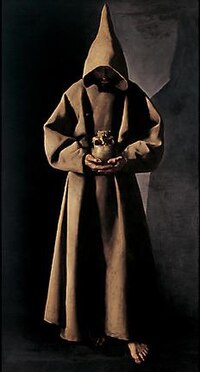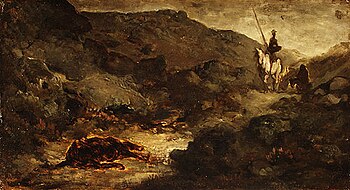Spanish Golden Age
From Wikipedia, the free encyclopedia.

The Spanish Golden Age (in Spanish, Siglo de Oro) was a period of flourishing in arts and letters in Spain and the Spanish-speaking countries of Latin America, coinciding with the political decline and fall of the Habsburgs (Phillip III, IV and Charles II). Sor Juana Inés de la Cruz, the last great writer of this golden age, died in New Spain in 1695.
Also, culturally (in literature and art) the golden age (siglo de oro) was in the 17th century, The Habsburgs, both in Spain and Austria, were great patrons of art in their countries. El Escorial, the great royal monastery built by King Philip II of Spain, invited the attention of some of Europe's greatest architects and painters. Diego Velázquez, regarded as one of the most influential painters of European history and a greatly respected artist in his own time, cultivated a relationship with King Philip IV and his chief minister, the Count-duke of Olivares, leaving several portraits to us that demonstrate his style and skill. El Greco, another respected Spanish artist from the period, infused Spanish art with the styles of the Italian renaissance and helped create a unique Spanish style of painting. Some of Spain's greatest music is regarded as having been written in the period, which such composers as Tomás Luis de Victoria, Luis de Milán and Alonso Lobo helping to shape Renaissance music and the styles of counterpoint and polychoral music, with their influence lasting far into the Baroque period. Spanish literature blossomed as well, most famously demonstrated in the work of Miguel de Cervantes, the author of Don Quixote de la Mancha. Spain's most prolific playwright, Lope de Vega, wrote over four hundred plays that survive to us to the present day of perhaps a thousand written in his own lifetime.

Contents |
Painting
Spain, in the time of the Italian Renaissance, had seen few great artists come to its shores. The Italian holdings and relationships made by Queen Isabella's husband and later Spain's sole monarch, Ferdinand of Aragon, launched a steady commerce of intellectuals across the Mediterranean between Valencia, Seville, and Florence that only rose with Spain's influence in Europe and Italy in particular. Luis de Morales, one of the leading exponents of Spanish mannerist painting, retained a distinctly Spanish style in his work reminiscent of medieval art. Spanish art, particularly that of Morales, contained a strong mark of mysticism and religion that was encouraged by the counter-reformation and the patronage of Spain's strongly Catholic monarchs and aristocracy.

Widely regarded as having the greatest impact in bringing the Italian Renaissance to Spain, El Greco, as his name implies, was not Spanish at all, but born as Domenikos Theotokopoulos in Crete. He studied the great Italians of his time - Titian, Tintoretto, and Michaelangelo - when he lived in Italy from 1568 to 1577. According to legend[1], after asserting that he would paint a mural as good as one of Michaelangelo's if they demolished one of the Italian artist's, El Greco quickly fell out of favor, and found a new home in the city of Toledo in southern Spain. He was influential in creating a style of impressions and emotion, with elongated fingers and vibrant color and brushwork. His paintings of the city of Toledo became models for a new European tradition in landscapes, influencing the work of the later Dutch masters.

Born in 1599, two generations after El Greco, Diego Velázquez is widely regarded as one of Spain's most important and influential artists. He was a court painter for King Philip IV and found increasingly high demand for his portraits from statesmen, aristocrats, and clergymen across Europe. His portraits of the King, his chief minister, the Count-duke of Olivares, and the Pope himself demonstrated a profound belief in artistic realism and a style that was reflected again in many of the Dutch masters. In the wake of the Thirty Years' War, Velázquez accompanied the marqués de Spinola on campaign in the Netherlands, where he painted his famous Surrender of Breda. He was struck by the ability to express emotion through reality in both his portraits and landscapes; his work in the latter, in which he launched one of European art's first experiments in outdoor lighting, became another lasting impression on Western painting. His friendship with Bartolome Esteban Murillo, a leading Spanish painter of the generation following Diego Velázquez's, ensured the enduring influence of his artistic approach.

The religious element in Spanish art, in many circles, grew in importance with the counter-reformation. The austere, ascetic, and severe work of Francisco de Zurbaran exemplified this thread in Spanish art, along with the work of composer Tomás Luis de Victoria. Philip IV actively patronized artists who agreed with his views on the counter-reformation and religion. The mysticism of Zurbaran's work - influenced by Saint Theresa of Avila - became a hallmark of Spanish art in later generations. Influenced by Caravaggio and the Italian masters, Zurbaran devoted himself to an artistic expression of religion and faith. His paintings of St. Francis of Assisi, the immaculate conception, and the crucifixion of Christ reflected a third facet of Spanish culture in the seventeenth century, against the backdrop of religious war across Europe. Zurbaran broke from Velázquez's sharp realist interpretation of art and looked, to some extent, to the emotive content of El Greco and the earlier mannerist painters for inspiration and technique, though Zurbaran respected and maintained the lighting and physical nuance of Velázquez.

Music
Spain's music was invigorated, as its painters were, by religion. Tomás Luis de Victoria, a Spanish composer of the sixteenth century, mainly of choral music, is widely regarded as one of the greatest among Spanish classical composers. He joined the cause of Ignatius of Loyola in the fight against the Reformation and in 1575 became a priest. He lived for a short time in Italy, where he became acquainted with the polyphonic work of Giovanni Pierluigi da Palestrina. Like Zurbaran, Victoria mixed the technical qualities of Italian art with the religion and culture of his native Spain. He invigorated his work with emotional appeal and experimental, mystical rhythm and choruses. He broke from the dominant tendency among his contemporaries by avoiding counterpoint, preferring longer, simpler, less technical and more mysterious melodies, employing dissonance in ways that the Roman school shunned. He demonstrated considerable invention in musical thought by connecting the tone and emotion of his music to those of his lyrics, particularly in his motets. Like Velázquez, Victoria was employed by the monarch - in Victoria's case, in the service of the queen. The requiem he wrote upon her death in 1603 is regarded as one of his most enduring and mature works.
Victoria's work was complemented by Alonso Lobo - a man Victoria respected as his equal. Lobo's work - also choral and religious in its content - stressed the austere, minimalist nature of religious music. Lobo sought out a medium between the emotional intensity of Victoria and the technical ability of Palestrina; the solution he found became the foundation of Baroque musical style in Spain.
The first known collection of Spanish guitar music was composed by Luis de Milán in 1536. Serving the ducal court of Valencia, Luis de Milán all but defined Spanish guitar music, which up to that point had been confined to the countryside rather than to the court. Spanish guitar - which had always been an important part of Spanish culture - began to experience a revival with Luis de Milán's work among Spanish aristocrats and merchants who popularized the style throughout Europe. Spanish guitar music (as shaped by Luis de Milán) would be revived again in the nineteenth century, and would retain a strong following to the present day.
Literature
Regarded by many as one of the finest works in the Spanish language, Don Quixote was one of the first novels published in Europe. The novel, in many ways like the world of its author, Miguel de Cervantes, was caught in between the Middle ages and the modern world. A veteran of the Battle of Lepanto (1571), Cervantes had fallen on hard times in the late 1590s and was imprisoned for debt in 1597, when he began work on his best-remembered novel. The final installment was published in 1615, a year before the author's death. Don Quixote resembled both the medieval, chivalric romances of an earlier time and the novels of the early modern world. It parodied classical morality and chivalry, found a comedy in of knighthood, and criticized social structures and the perceived madness of Spain's rigid society. The work has endured to the present day as a landmark in world literary history, an immediate international hit in its own time, with interpretations varying from sheer comedy to social commentary to politics.

A contemporary of Cervantes, the playwright Lope de Vega is best remembered for his dramas, particularly those grounded in Spanish history. Like Cervantes, Lope de Vega served with the Spanish army and was fascinated with the antique Spanish nobility. Through the hundreds of plays he wrote in settings ranging from the Bible to legendary Spanish history to classical mythology to his modern day, Lope de Vega took a comical approach just as Cervantes did, taking a conventional moral play and dressing it up in good humor and cynicism. His primary goal was to entertain the public, however, much as Cervantes's was. In bringing morality, comedy, drama, and popular wit together, Lope de Vega is often compared to Shakespeare, another contemporary figure. As a social critic, Lope de Vega attacked, like Cervantes, many of the ancient institutions of his country - the aristocracy, chivalry, rigid morality, among others. The two authors represented an alternative artistic perspective to the religious ascetism of Francisco Zurbaran. Lope de Vega's "cloak-and-sword" plays that mingled intrigue, romance, and comedy together were carried on by his literary successor, Pedro Calderón de la Barca, in the later seventeenth century.
Significant authors include
- Francisco de Quevedo
- Sor Juana Inés de la Cruz
- Alonso de Ercilla (Chilean poet)
- Juan Ruiz de Alarcón
- Gil Vicente Vicente was Portuguese but his influence on Spanish playwriting was so wide that he is often considered part of the Spanish Golden Era.
Significant painters include
- El Greco (Domenicos Theotokopolous)
- Luis de Morales
- Bartolomé Esteban Murillo
- José de Ribera
- Diego Velázquez
- Francisco Zurbarán
See also
- History of Spain
- Spanish Empire
- Golden age of Jewish culture in Spain (during the earlier Islamic domination)


